You can transform your garden into a natural fortress against destructive pests by strategically planting lavender, whose powerful linalool and camphor compounds create an invisible chemical barrier that disrupts insect olfactory systems and drives away mosquitoes, aphids, moths, and flies. Position English or French lavender varieties near doorways, windows, and vulnerable crops like tomatoes for maximum protection. Pair it with rosemary, marigolds, and basil to amplify its pest-repelling effectiveness while creating a beautiful, fragrant landscape that’ll reveal even more powerful defense strategies.
The Natural Chemistry Behind Lavender’s Pest-Repelling Power
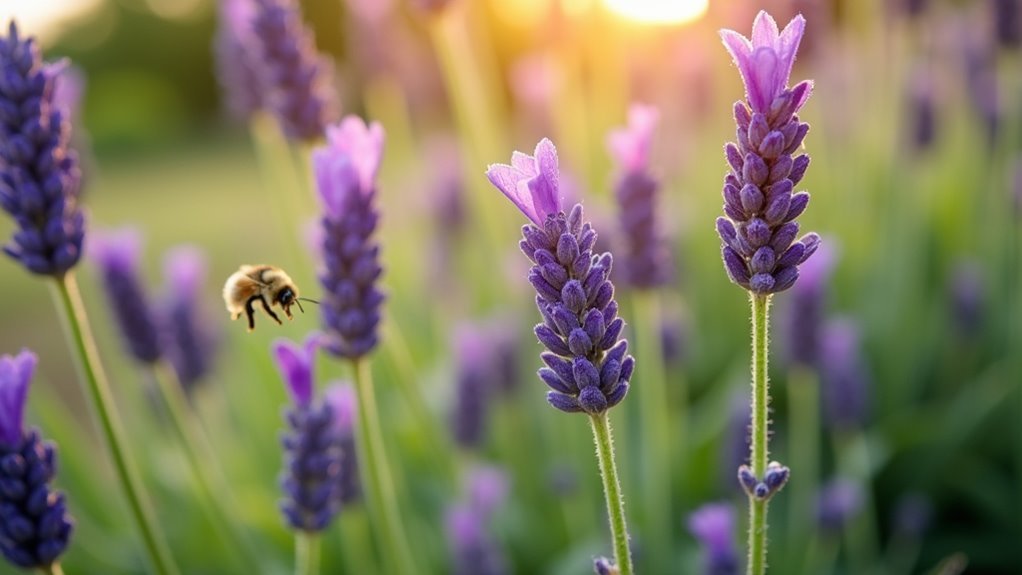
Nature’s chemistry lab works overtime in lavender plants, producing powerful aromatic compounds that serve as your garden’s first line of defense against unwanted pests. The key players here are linalool and camphor – two potent molecules that directly disrupt insects’ olfactory receptors.
Nature’s aromatic arsenal deploys linalool and camphor as molecular defenders, turning your lavender garden into an impenetrable fortress against invading pests.
When you plant lavender strategically around your garden, these compounds create an invisible barrier that mosquitoes, moths, fleas, and flies simply can’t tolerate.
What makes lavender such an effective insect repellent isn’t just its pleasant fragrance to humans, but rather its ability to confuse and overwhelm pest insects’ sensory systems.
Different lavender species contain varying concentrations of these pest-fighting compounds, so you’ll want to choose varieties that best repel pests specific to your region for maximum garden protection.
Best Lavender Varieties for Maximum Pest Control
When selecting lavender varieties for your garden’s pest defense strategy, English Lavender (Lavandula angustifolia) stands out as your most reliable choice. You’ll find its strong scent effectively repels aphids and mosquitoes, making it essential for natural pest control.
French Lavender (Lavandula stoechas) offers equally potent fragrance, working excellently in both outdoor gardens and indoor spaces.
These lavender plants contain powerful aromatic compounds like linalool and camphor that confuse and deter insects, maximizing their pest-repelling properties.
You’ll create an even stronger defense by planting different varieties together, which not only boosts pest control benefits but also attracts beneficial insects. This strategic combination establishes a balanced ecosystem that protects your garden while adding visual appeal and diversity to your landscape.
Strategic Placement for Optimal Garden Protection
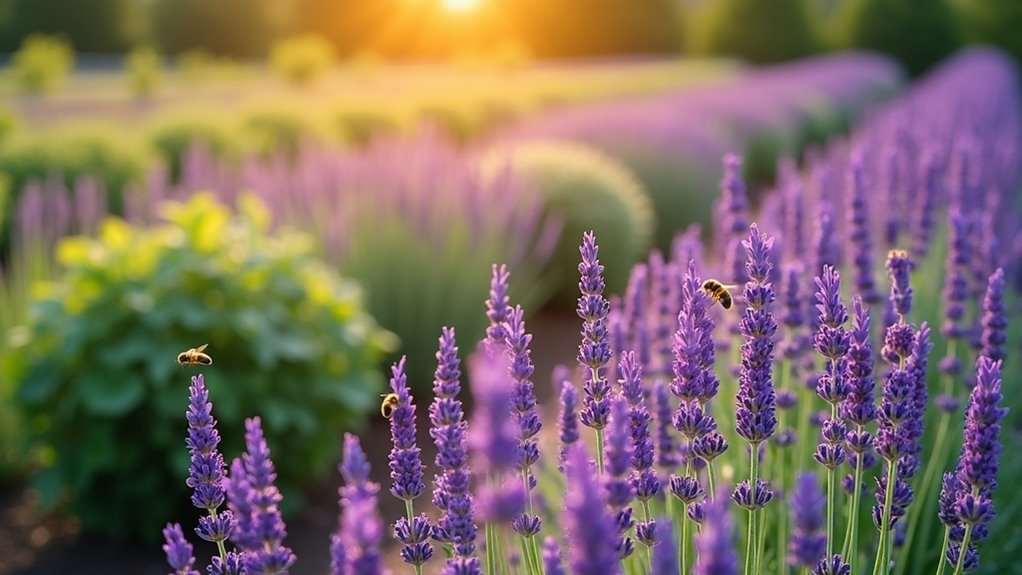
You’ll maximize lavender’s pest-repelling power by positioning it strategically around your garden’s most vulnerable areas.
Place these fragrant defenders near doorways, windows, and patios to create natural barriers that block insects from reaching your home.
You can also use lavender as a protective companion plant, positioning it next to susceptible vegetables like tomatoes and carrots to mask their appealing scents from hungry pests.
Entry Point Barriers
Strategic positioning transforms lavender from a simple garden herb into a powerful defensive fortress against unwanted pests.
By placing lavender plants near entrances, patios, and windows, you’ll create an effective natural barrier that stops pests before they reach your home and outdoor living spaces.
The key to maximizing lavender’s protective power lies in understanding how these aromatic plants repel unwanted visitors.
Position them at critical access points where insects typically enter your property. The strong, distinctive scent creates an invisible shield that deters moths, flies, mosquitoes, and other common household pests.
Don’t overlook doorways, garden gates, and porch areas when planning your lavender placement.
These high-traffic zones benefit most from lavender’s natural pest-deterrent properties, ensuring your family enjoys pest-free outdoor entertaining and indoor comfort.
Companion Plant Protection
Beyond protecting your home’s perimeter, lavender serves as a powerful ally for vulnerable plants throughout your garden. When you plant lavender near tomatoes, carrots, and lettuce, its strong fragrance effectively masks their attractive odors that typically draw harmful pests. This companion planting strategy creates an invisible shield around your vegetables, confusing insects and reducing damage to your crops.
You’ll also discover that lavender doesn’t just repel insects like mosquitoes and other harmful pests—it attracts beneficial predators like ladybugs and lacewings. These helpful insects feed on aphids and other destructive garden invaders, creating a natural balance in your ecosystem.
Position lavender strategically between rows of vegetables or along garden borders to maximize this protective effect while maintaining proper spacing for healthy plant growth.
Companion Plants That Amplify Lavender’s Effectiveness
While lavender stands as a formidable pest deterrent on its own, pairing it with strategic companion plants creates an even more powerful defense system for your garden.
Lavender as a pest repellent becomes markedly more effective through thoughtful companion planting combinations.
Rosemary and thyme enhance lavender’s pest-repelling abilities, forming a natural barrier against harmful insects.
Marigolds add vibrant color while deterring aphids, whiteflies, and nematodes with their potent scents.
Basil’s strong fragrance complements lavender perfectly, repelling mosquitoes and flea beetles while providing culinary value.
Consider planting alliums like chives and garlic nearby to ward off cabbage worms and slugs.
Mint creates another layer of protection against mosquitoes while offering aromatic and culinary benefits for your kitchen.
Planting and Establishing Lavender for Pest Management
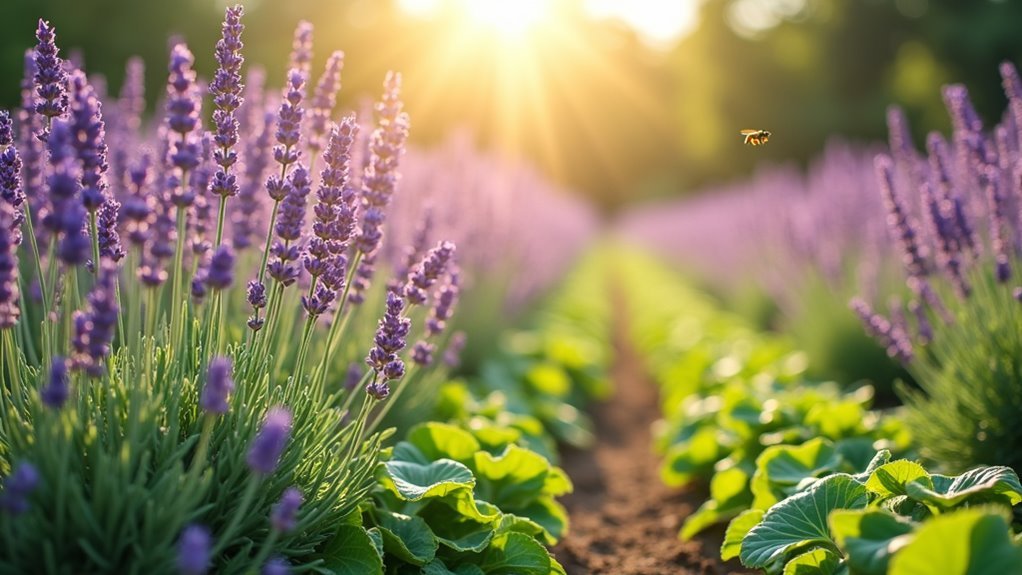
To harness lavender’s full pest-repelling potential, you’ll need to master the fundamentals of proper establishment.
Your success depends on providing well-draining soil with 6-8 hours of daily sunlight, which strengthens the plant’s natural defenses against unwanted insects.
Strategic spacing and regular pruning techniques will guarantee your lavender develops into an effective barrier that keeps pests at bay.
Optimal Soil and Sunlight
Creating the perfect growing environment for lavender requires attention to two critical factors: soil composition and sunlight exposure.
You’ll need ideal soil that drains well and maintains a pH between 6.5 and 7.5. This specific range supports your lavender’s growth while maximizing its pest-repelling properties.
Your lavender plants demand full sunlight, needing at least 6 to 8 hours of direct exposure daily. This abundant sunshine enables them to produce the aromatic oils that effectively deter unwanted insects.
Without adequate light, you’ll notice reduced oil production and diminished pest control capabilities.
Well-draining soil prevents root rot while the proper pH level guarantees nutrient absorption.
When you combine these soil conditions with generous sunlight, you’re creating an environment where lavender thrives and functions as your garden’s natural pest barrier.
Spacing and Pruning Techniques
Once you’ve established the right soil and sunlight conditions, proper spacing becomes your next priority for maximizing lavender’s pest-deterrent power.
Plant your lavender 12 to 18 inches apart to guarantee adequate airflow between plants. This spacing prevents disease while allowing each plant’s pest-repelling aroma to circulate effectively throughout your garden.
Regular pruning maintains your lavender’s defensive capabilities. Trim plants in early spring or late fall to stimulate healthy growth and enhance their pest-repelling properties.
Remove spent blooms through deadheading to encourage continuous flowering and preserve the plant’s fragrance intensity. This consistent maintenance keeps your lavender’s scent strong, guaranteeing it continues deterring harmful insects while protecting neighboring plants.
Proper spacing and pruning create an effective barrier that promotes a healthier garden ecosystem.
Maintenance Practices That Boost Repellent Properties
While lavender naturally repels pests through its aromatic oils, you’ll maximize these protective qualities through strategic maintenance practices that keep your plants thriving.
Regular deadheading and pruning in early spring or late fall enhance your lavender’s health while promoting robust aromatic compounds that effectively repel mosquitoes and other insects.
Harvest flowers consistently to encourage new growth and boost essential oil concentration, strengthening your plant’s pest-repelling capabilities.
Apply organic mulch around your lavender to retain soil moisture without waterlogging, supporting healthy development and maximizing aromatic potential.
Maintain well-draining soil and guarantee ample sunlight, as healthy plants produce stronger scents that deter unwanted visitors.
These maintenance practices work together to transform your lavender into a powerful, natural pest control system.
Indoor Applications of Lavender for Pest Control
You can extend lavender’s pest-fighting power beyond your garden by bringing it indoors through dried sachets and potted plants.
These indoor applications won’t just repel moths, ants, and other unwanted insects—they’ll also fill your home with lavender’s signature calming fragrance.
Whether you’re tucking sachets into dresser drawers or positioning live plants near windows, you’re creating natural barriers that protect your living spaces without harsh chemicals.
Dried Lavender Sachets
Moths and other fabric-damaging insects don’t stand a chance against dried lavender sachets strategically placed throughout your home.
These natural insect repellent pouches contain linalool and other aromatic compounds that create a strong fragrance insects can’t tolerate, confusing and deterring them from your clothing and linens.
You’ll find making these sachets incredibly simple – just fill small fabric bags with dried lavender flowers.
Place them in closets, drawers, and storage areas where you need protection.
Beyond pest control, they’ll create a calming atmosphere thanks to lavender’s stress-relief properties while filling your spaces with pleasant fragrance.
Best of all, your dried lavender sachets remain effective for several months, providing cost-effective, eco-friendly pest protection.
Indoor Growing Benefits
Beyond creating sachets from dried flowers, growing fresh lavender indoors amplifies your pest control arsenal while bringing nature’s protective power directly into your living spaces.
You’ll discover that cultivating this natural insect deterrent requires minimal effort while maximizing benefits.
When you grow lavender indoors, you’re accessing continuous pest protection through these advantages:
- Strategic placement – Position containers near windows and entryways where insects typically enter
- Dual-purpose benefits – Enjoy lavender essential oil production alongside pest control
- Enhanced potency – Fresh plants release stronger aromatic compounds like linalool than dried alternatives
Your indoor lavender plants work around the clock, releasing protective scents that repel moths and other unwanted visitors.
You’ll appreciate how this low-maintenance approach creates a calming atmosphere while safeguarding your home naturally.
Harvesting Techniques to Maximize Pest-Fighting Benefits
Three essential factors determine whether your lavender harvest will deliver maximum pest-repelling power: timing, technique, and post-harvest handling.
You’ll want to harvest during peak bloom in late spring to early summer when essential oils reach their highest concentration. Cut stems in the morning after dew dries but before midday heat compromises the fragrant compounds.
Use sharp, clean shears to make precise cuts just above the leaves. This promotes healthy regrowth while preserving the plant’s vigor for future harvests.
Clean, precise cuts above leaf nodes ensure vigorous regrowth and maintain your lavender’s long-term harvesting potential.
Immediately hang your lavender upside down in a dark, dry, well-ventilated space to dry properly. This process enhances the pest-repelling properties you’re after.
Don’t forget to deadhead and prune after harvesting. Regular maintenance stimulates new growth and keeps your lavender’s defensive capabilities strong throughout the growing season.
Combining Lavender With Other Natural Deterrents
Creating a multi-layered defense system amplifies lavender’s natural pest-fighting abilities when you strategically combine it with complementary plants.
This approach maximizes your garden’s protective barrier while reducing chemical pesticide dependency.
Here are three powerful lavender combinations that enhance pest control:
- Lavender + Rosemary – Both plants’ strong fragrances create a potent repellent against mosquitoes and various insects, doubling your aromatic defense.
- Lavender + Mint – This combination effectively deters ants, flies, and mosquitoes, with mint’s scent complementing lavender’s natural properties.
- Lavender + Marigolds – Marigolds target nematodes, aphids, and whiteflies while lavender handles other pests, providing extensive garden protection.
Adding citronella grass or basil creates an even more robust system.
These plants that repel pests work synergistically, promoting biodiversity while maintaining a harmonious, chemical-free garden environment.
Creating a Multi-Layered Defense System With Lavender
When you establish multiple barriers of protection throughout your garden, lavender becomes the cornerstone of an impenetrable pest defense network.
You’ll amplify its effectiveness by densely planting lavender alongside marigolds and rosemary, creating overlapping zones that repel different pest species.
Position various lavender varieties strategically near vulnerable crops like tomatoes and carrots to mask their scents and confuse harmful insects.
Strategic lavender placement near tomatoes and carrots creates aromatic camouflage that disrupts pest navigation while protecting your most vulnerable crops.
Your defense system strengthens when you incorporate multiple lavender species, each contributing unique aromatic compounds that target broader pest ranges.
Regular harvesting enhances these repelling properties while encouraging vigorous new growth.
This multi-layered approach transforms lavender from a simple deterrent into your garden’s primary shield, where beneficial pollinators thrive while destructive pests stay away, ensuring your crops remain healthy and productive.
Frequently Asked Questions
What Animal Does Lavender Keep Away?
Lavender’ll keep deer and rabbits away from your garden plants. You’ll also find it repels mosquitoes, moths, and fleas effectively. Its strong scent confuses insects’ olfactory receptors, making them avoid the area completely.
How to Use Lavender for Pest Control?
Plant lavender near entrances and windows to create natural barriers. Harvest regularly to enhance aromatic oils. Use dried sachets indoors for moths. Combine with rosemary and mint for layered garden protection.
What Kind of Lavender Repels Bugs?
You’ll find English Lavender most effective for repelling mosquitoes, moths, and flies. French Lavender’s also excellent with its potent scent. Both contain linalool and camphor that confuse insects’ receptors, deterring pests naturally.
What Rodents Does Lavender Repel?
You’ll find lavender effectively repels mice and rats. These rodents dislike lavender’s strong scent, which disrupts their sensory perception. Plant it near entry points to create natural barriers around your home and garden.
In Summary
You’ve discovered lavender’s incredible potential as your garden’s natural pest deterrent. By selecting the right varieties, positioning them strategically, and combining them with complementary plants, you’ll create a powerful defense system. Don’t forget to harvest properly and integrate other natural methods for maximum effectiveness. Start planting lavender today, and you’ll enjoy a beautiful, fragrant garden that naturally keeps unwanted pests at bay while attracting beneficial insects.

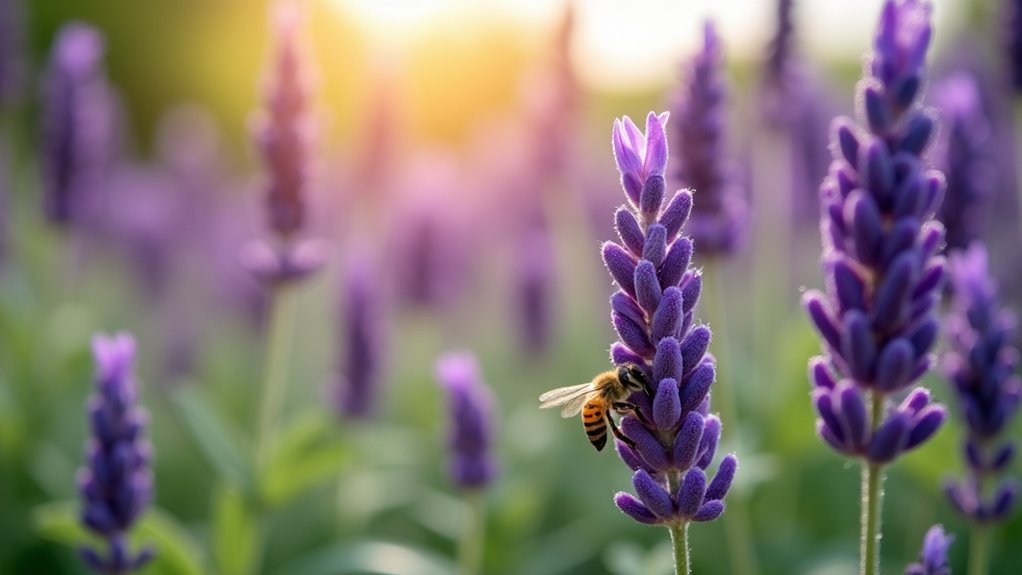

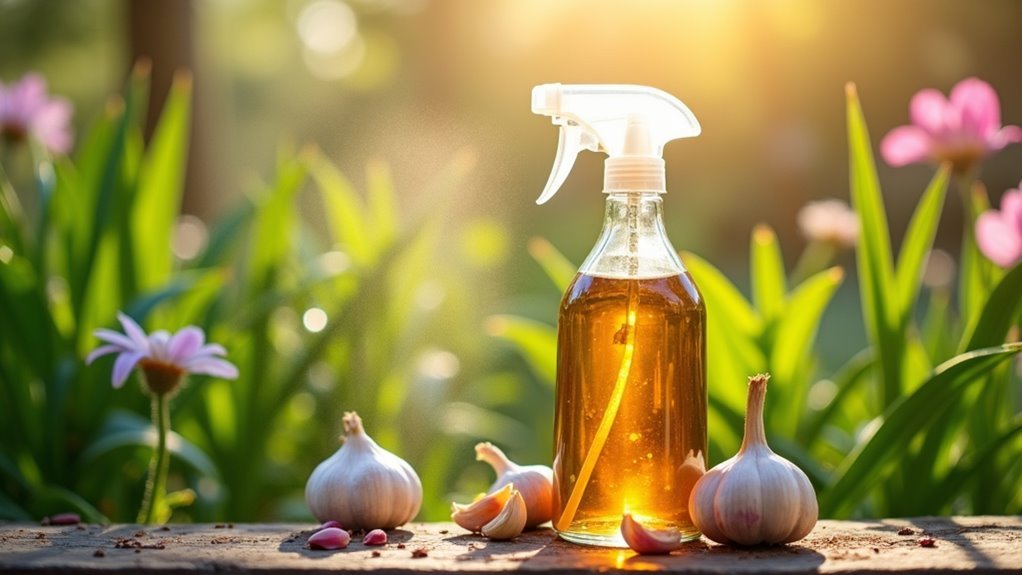
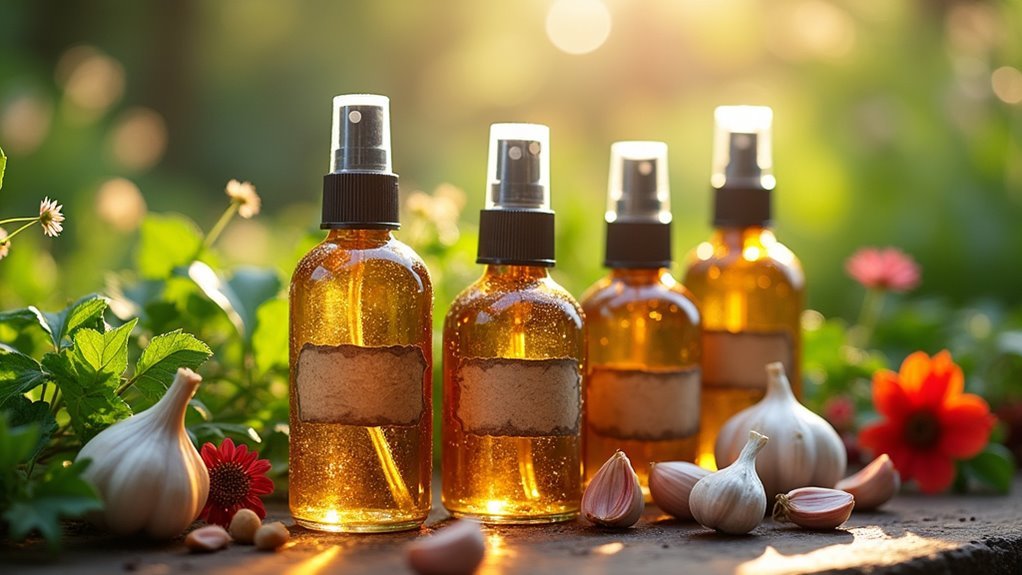
Leave a Reply